GetStudySolution
Getstudysolution is an online educational platform that allows students to access quality educational services and study materials at no cost.
NCERT Solutions for class 7 Maths chapter 3 – Data Handling
Back Exercise
Exercise 3.1
Question 1.
Find the range of heights of any ten students of your class.
Solution:
Let the heights (in cm) of 10 students in the class be 150, 152, 151, 148, 149, 149, 150, 152, 153, 146.
Arranging the heights in ascending order, we have 146, 148, 149, 149, 150, 150, 151, 152, 152, 153.
Range of height of students = 153 – 146 = 7
Question 2.
Organize the following marks in a class assessment, in a tabular form.
4, 6, 7, 5, 3, 5, 4, 5, 2, 6, 2, 5, 1, 9, 6, 5, 8, 4, 6, 7
(i) Which number is the highest?
(ii) Which number is the lowest?
(iii) What is the range of the data?
(iv) Find the arithmetic mean.
Solution:
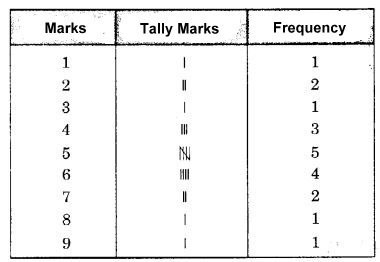
(i) Highest number is 9.
(ii) Lowest number is 1.
(iii) Range of the data = Highest observation – Lowest observation
= 9 – 1
= 8

Question 3.
Find the mean of the first five whole numbers.
Solution:
The first 5 whole numbers are 0, 1, 2, 3, and 4.
Their arithmetic mean
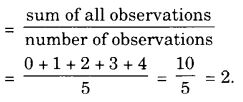
Question 4.
A cricketer scores the following runs in eight innings:
58, 76, 40, 35, 46, 45, 0, 100.
Find the mean score.
Solution:
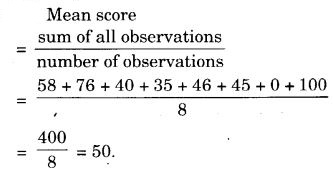
Question 5.
Following table shows the points of each player scored in four games:
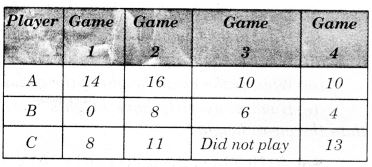
Now answer the following questions:
- Find the mean to determine A’s average number of points scored per game.
- To find the mean number of points per game for C, would you divide the total points by 3 or by 4? Why?
- B played in all four games. How would you find the mean?
- Who is the best performer?
Solution:
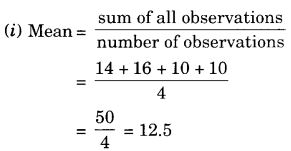
So, A’s average number of points scored per game is 12.5.
(ii) To find the mean number of points per game for C, we shall divide the total points by 3 because the number of games under consideration is 4 but ‘C’ did not play game 3.
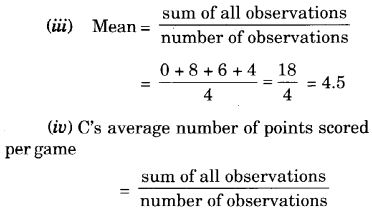

Question 6.
The marks (out of 100) obtained by a group of students in a science test are 85, 76, 90, 85, 39, 48, 56, 95, 81 and 75. Find the:
- Highest and the lowest marks obtained by the students.
- Range of the marks obtained.
- Mean marks obtained by the group.
Solution:
- Highest marks obtained by the students = 95
Lowest marks obtained by the students = 39 - Range of the marks obtained = Highest marks – Lowest marks = 95 – 39 = 56
- Mean marks obtained by the group
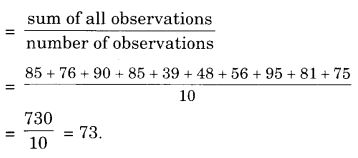
Question 7.
The enrolment of a school during six consecutive years was as follows:
1555, 1670, 1750, 2013, 2540, 2820.
Find the mean enrolment of the school for this period.
Solution:
Mean enrolment of the school for this period.

Question 8.
The rainfall (in mm) in a city on 7 days of a certain week was recorded as follows:

(i) Find the range of the rainfall in the above data.
(ii) Find the mean rainfall for the week.
(iii) On how many days was the rainfall less than the mean rainfall?
Solution:
(i) Range of the rainfall = Highest rainfall – Lowest rainfall = 20.5 mm – 0.0 mm = 20.5 mm
(ii) Mean rainfall for the week
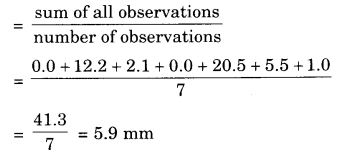
(iii) The rainfall was less than the mean rainfall on 5 days.
Question 9.
The heights of 10 girls were measured in cm and the results are as follows:
135, 150, 139, 128, 151, 132, 146, 149, 143, 141.
(i) What is the height of the tallest girl?
(i) What is the height of the shortest girl?
(iii) What is the range of the data?
(iv) What is the mean height of the girls?
(v) How many girls have heights more than the mean height?
Solution:
(i) Height of the tallest girl = 151 cm
(ii) Height of the shortest girl = 128 cm
(iii) Range of the data
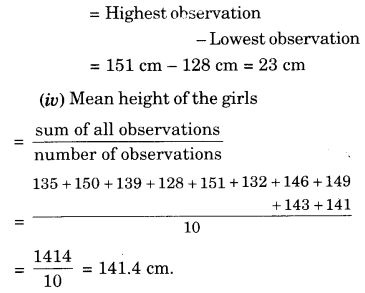
(v) 5 girls have heights more than the mean height.
Exercise 3.2
Question 1.
The scores in mathematics test (out of 25) of 15 students is as follows:
19, 25, 23, 20, 9, 20, 15, 10, 5, 16, 25, 20, 24, 12, 20
Find the mode and median of this data. Are they the same?
Solution:
For Median. We arrange the data in ascending order, we get
5, 9, 10, 12, 15, 16, 19, 20,
20, 20, 20, 23, 24, 25, 25
Median is the middle observation.
Therefore, 20 is the median.
For Mode.
Mode = Observation with highest frequency = 20
Yes, they are the same.
Question 2.
The runs scored in a cricket match by 11 players is as follows:
6, 15, 120, 50, 100, 80, 10, 15, 8, 10, 15.
Find the mean, mode, and median of this data. Are the three same?
Solution:
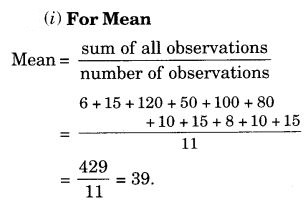
(ii) For Median. We arrange the data in ascending order, we get
6, 8, 10, 10, 15, 15, 15, 50, 80, 100, 120
Median is the middle observation. Therefore, 15 is the median.
(iii) For Mode. Mode = observation with highest frequency = 15
No! They are not the same.
Question 3.
The weights (in kg.) of 15 students of a class are:
38, 42, 35, 37, 45, 50, 32, 43,
43, 40, 36, 38, 43, 38, 47
- Find the mode and median of this data.
- Is there more than one mode?
Solution:
(i) For Median. We arrange the data in ascending order, we get
32, 35, 36, 37, 38, 38, 38, 40, 42, 43, 43,
43, 45, 47, 50
Median is the middle observation.
Therefore, 40 kg is the median.
For Mode. Mode = observation with highest frequency = 38 kg and 43 kg.
(ii) Yes! there are 2 (more than one) modes.
Question 4.
Find the mode and median of the data:
13, 16, 12, 14, 19, 12, 14, 13, 14.
Solution:
For Median. We arrange the data in ascending order, we get 12, 12, 13, 13, 14, 14, 14, 16, 19.
Median is the middle observation.
Therefore, 14 is the median.
For Mode. Mode = observation with highest frequency = 14.
Question 5.
Tell whether the statement is true or false:
- The mode is always one of the numbers in data.
- The mean is one of the numbers in a data.
- The median is always one of the numbers in a data.
- The data 6, 4, 3, 8, 9, 12, 13, 9 has a mean of 9.
Solution:
- True
- False
- True
- False.
Exercise 3.3
Question 1.
Use the bar graph to answer the following questions.
(a) Which is the most popular pet?
(b) How many children have dog as a pet?
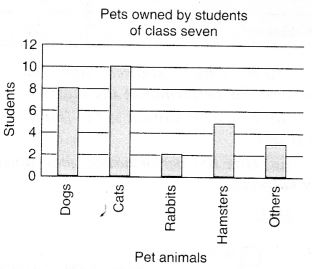
Solution:
(a) The most popular pet is ‘Cat’.
(b) 8 children have a dog as a pet.
Question 2.
Read the bar graph which shows the number of books sold by a bookstore during five consecutive years and answer the following questions:
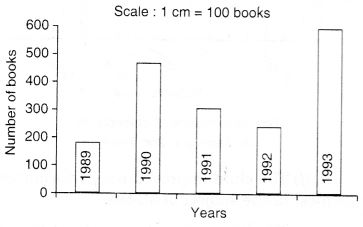
- About how many books were sold in 1989?1990?1992?
- ln which year were about 475 books sold? About 225 books sold?
- In which years were fewer than 250 books sold?
- Can you explain how you would estimate the number of books sold in 1989?
Solution:
Clearly, from the given graph, we have
- Number of books sold in the year
1989: 170 (approx.)
1990: 475 (approx.)
1992: 225 (approx.) - In the year 1990, about 475 books were sold. In the year 1992, about 225 books were sold.
- Fewer than 250 books were sold in the years 1989 and 1992.
- It can be estimated using the height of the bar such that the height of 1 cm = 100 books.
Question 3.
The number of children in six different classes is given below. Represent the data on a bar graph.

(a) How would you choose a scale?
(b) Answer the following questions:
(i) Which class has the maximum number of children? And the minimum?
(ii) Find the ratio of students of class sixth to the students of the class eighth.
Solution:
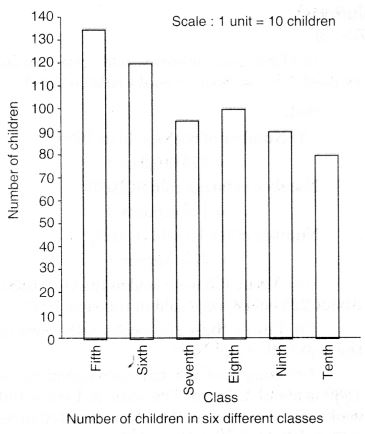
(a) Start the scale at 0. The greatest value in the data is 135, so end the scale at a value greater than 135, such as 140. Use equal divisions along the axes, such as increments of 10.
We know that all the bars would lie between 0 and 140.
We choose the scale such that the length between 0 and 140 is neither too long nor too small.
Here, we take 1 unit for 10 children.
(b) (i) Fifth class has the maximum number of children. Tenth class has the minimum number of children.
(ii) Ratio of students of class sixth to eighth = 120 : 100 =
Question 4.
The performance of a student in 1st Term and, 2nd Term is given. Draw a double bar graph choosing the appropriate scale and answer the following :
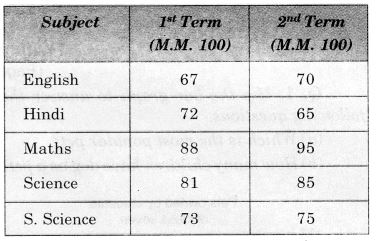
- In which subject, has the child improved his performance the most?
- In which subject is the improvement the least?
- Has the performance gone down in any subject?
Solution:
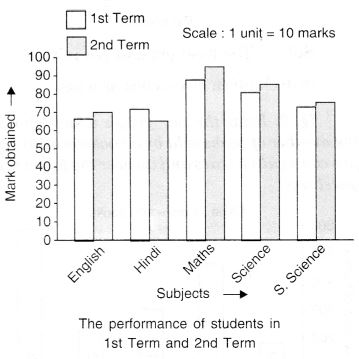
- The child improved his performance the most in the subject of Maths.
- The improvement is the least in the subject of S. Science.
- Yes! The performance has gone down in the subject of Hindi.
Question 5.
Consider this data collected from a survey of a colony.

- Draw a double graph choosing an appropriate scale.
What do you infer from the bar graph? - Which sport is most popular?
- Which is more preferred, watching or participating in sports?
Solution:
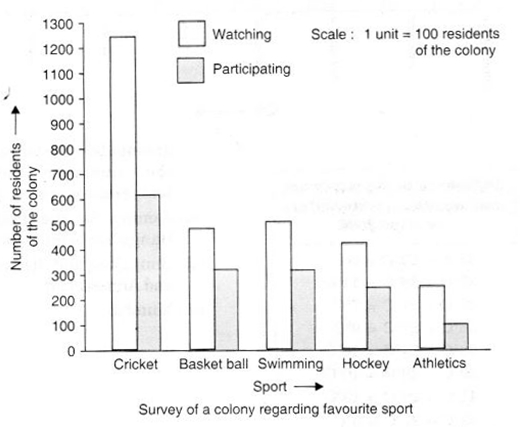
- It is inferred that more people prefer cricket and fewer athletics.
- The most popular sport is cricket.
- Watching is more preferred than participating.
Question 6.
Take the data giving the minimum and the maximum temperature of various cities given at the beginning of this chapter. Plot a double bar graph using the data and answer the following:
- Which city has the largest difference in the minimum and maximum temperature on the given date?
- Which is the hottest city and which is the coldest city?
- Name two cities where the maximum temperature of one was less than the minimum temperature of the other.
- Name the city which has the least difference between its minimum and the maximum temperature.
Solution:
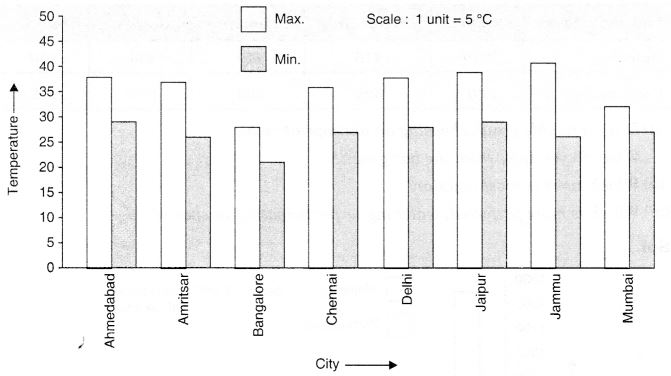
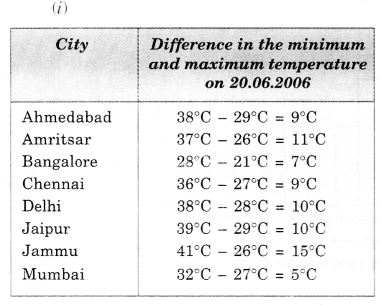
- The city Jammu has the largest difference in the minimum and maximum temperature on the given date.
- Jammu is the hottest city and Bangalore is the coldest city.
- The name of the two cities where the maximum temperature of one was less than the minimum temperature of the other is Bangalore and Jaipur or Bangalore and Ahmedabad.
- Mumbai has the least difference between its minimum and maximum temperature.
Exercise 3.4
Question 1.
Tell whether the following is certain to happen, impossible, can happen but not certain.
- You are older today than yesterday.
- A tossed coin will land heads up.
- A die when tossed shall land up with 8 on top.
- The next traffic light seen will be green.
- Tomorrow will be a cloudy day.
Solution:
- Certain to happen
- Can happen but not certain
- Impossible
- Can happen but not certain
- Can happen but not certain
Question 2.
There are 6 marbles in a box with numbers from 1 to 6 marked on each of them.
- What is the probability of drawing a marble with the number 2?
- What is the probability of drawing a marble with the number 5?
Solution:
Out of 6 marbles, one can be drawn in 6 ways. So, the total number of events = 6
1. The marble with the number 2 can be obtained only in one way.
∴ Required probability =
2. The marble with the number 5 can be obtained only in one way.
∴ Required probability =
Question 3.
A coin is flipped to decide which team starts the game. What is the probability that your team will start?
Solution:
On tossing a coin, the possible outcomes are head (H) or tail (T).
Required probability =